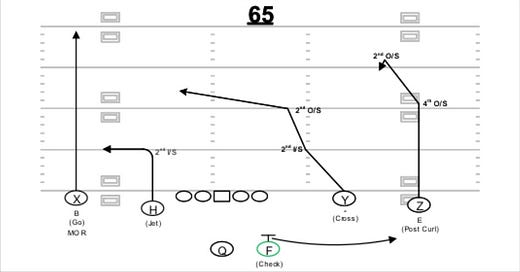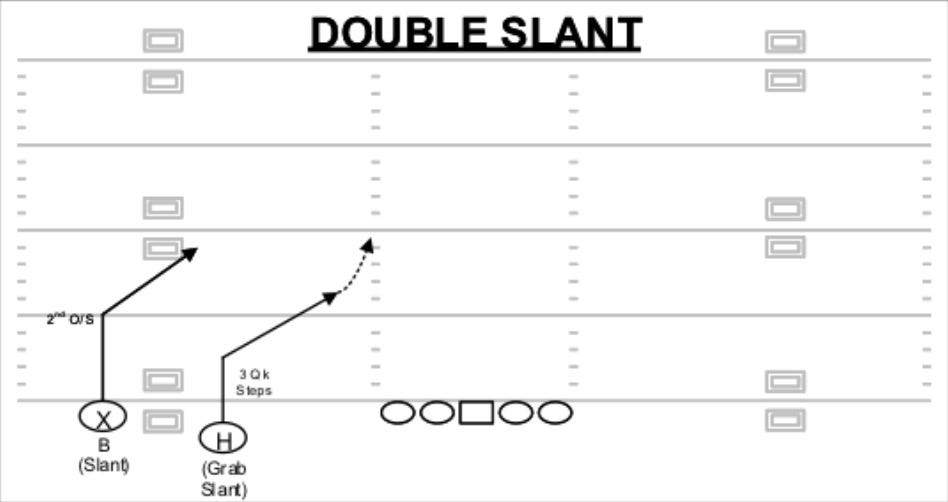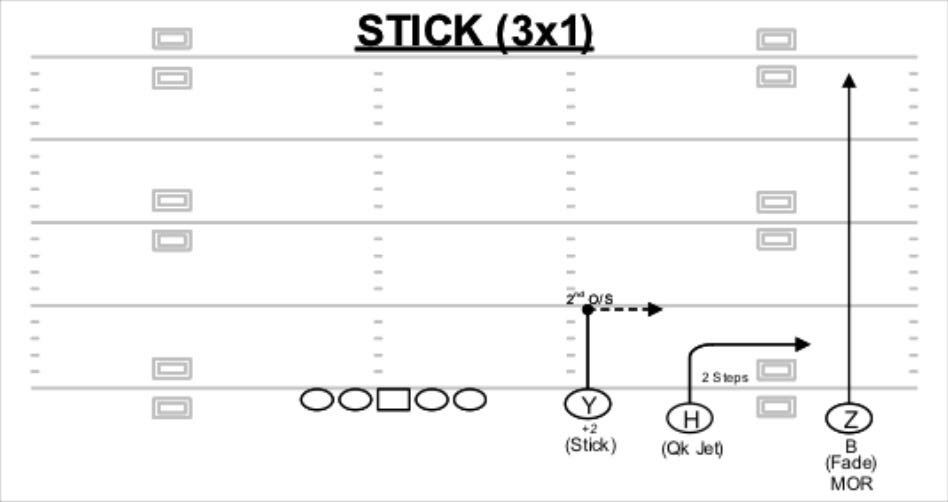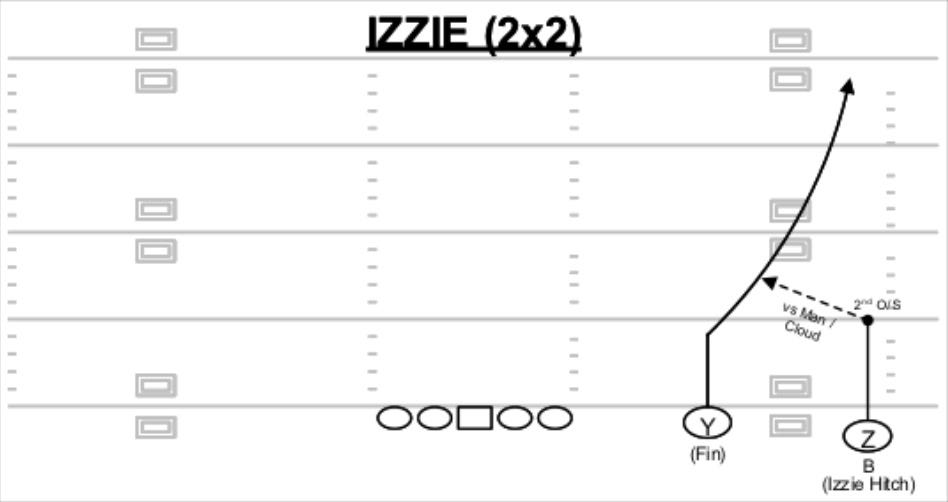Breaking down Commanders rookie minicamp practice
Taking a closer look at some passing concepts from the Commanders rookie minicamp
Over the weekend the Washington Commanders held their rookie minicamp. It was the first time we got to see some practice clips of the Commanders rookie class in action. Normally I wouldn’t be writing about rookie minicamp practice clips, but I saw something I found interesting. My former colleague Ben Standig at The Athletic and host of the excellent Standig Room Only podcast, tweeted out a few clips he was allowed to film from practice sessions open to the media on Friday and Saturday.
Friday practice clips: https://x.com/benstandig/status/1789085702484820401?s=61&t=tNRbe9bmEPrJChOH0fYe-A
Saturday practice clips: https://x.com/benstandig/status/1789356539708383347?s=61&t=tNRbe9bmEPrJChOH0fYe-A
(Note: Unfortunately tweets no longer embed in Substack posts)
In these clips, I noticed a different way of practicing from the clips we typically see. Normally in practice sessions open to the media, you’ll see quarterbacks throwing individual routes to a single receiver, often alternating between quarterback and which side of the field the receiver lines up. Last year, Eric Bieniemy brought more tempo by having two quarterbacks throw passes at the same time, with one throwing a receiver on the left of the field while the other throws to a receiver to the right. That sped up the process and got more reps into a smaller window of practice, which was good, but it appears as though Kliff Kingsbury has taken things a step further.
In these clips, you’ll see both rookie quarterbacks Jayden Daniels and undrafted free agent Sam Hartman taking reps at the same time. Sometimes an assistant coach even joins in as a third quarterback. But the quarterbacks aren’t just throwing individual routes to opposite sides of the field, instead they are practicing reading out route combinations. Two receivers align on one side of the field and run some form of route combination, allowing the quarterbacks to get a view of what that combination looks like on the field instead of just in the playbooks. The quarterbacks then practice reading the play out, with one quarterback throwing to the first read and the other throwing to the second read slightly after.
Having mentioned this difference in reply to one of Ben’s tweets, twitter user @Lawson_sts noted this is a common practice method for Air Raid coaches, which is the system Commanders offensive coordinator Kliff Kingsbury derives from. That same twitter user linked a video from Mike Leach explaining the drill:
The drill in question starts at 15:07 in that video.
So having now seen an interesting twist on how they’re practicing, we can also see what route combinations they’re practicing. So I’ve taken a few of Ben’s clips and cut them up together alongside diagrams of the concepts I believe they are practicing from an old Kliff Kingsbury playbook I found online. Let’s take a closer look.
Double Slant
The first and most basic concept we have in these clips is the double slant concept. In the west coast offense, this would be known as Lion. It’s a very simple combination with two receivers to the same side of the field, both running slant routes. The quarterbacks typically work inside-out, meaning they start with the inside slant and then work out to the outside slant if they can’t throw the inside slant first. You can see from this clip how both Daniels and Hartman catch the snap from the shotgun, take one step back to set themselves and then deliver their respective passes. Hartman takes the inside slant and Daniels hits the outside slant just slightly after.
This is a good concept against man coverage as slant routes are always tough to defend one-on-one, but also against most single-high safety zone coverages like Cover-3. The inside slant can drag the underneath zone defenders inside, creating space for the outside slant to run into. Against two-deep safety zone coverages like Cover-2 though, it's tough to run this concept. As a result, it’s often a concept paired with a different concept on the other side of the field. You might see it paired with a basic stick combination on the other side of the field, which is a better concept against two-deep safety zone coverages, giving the quarterback the ability to work either side depending on what coverage he sees pre and post-snap.
Stick
Having just mentioned stick as a possible pairing to go with double slant, I thought we could look at the stick concept too. Now the diagram for this play is slightly different to how the Commanders run it in the clip. The diagram shows it in a three by one formation, with three receivers to the right. The outside receiver runs a clear out vertical route down the sideline which normally isn’t part of the progression and is only to be alerted against specific looks, like Cover-2 if the corner is aggressive in playing the flat and the safety over the top doesn’t get enough width.
The core of the concept is the two inside receivers though. The innermost receiver runs a stick route, getting to about five yards of depth before sticking his foot in the ground and breaking off the route. He can read the coverage and either stop on the spot or break outside away from the coverage. The other receiver runs immediately out to the flat. You’ll see stick concepts run from a variety of different looks and the Commanders use a different look in this clip from the one you see in the diagram. They have the tight end run the stick route with the running back in the backfield working out to the flat.
Stick is a core concept that every team in the NFL runs because it has a variety of uses. It’s good against man coverage especially from a look like this, because the stick route can get in the way of any linebacker trying to cover the running back in the flat. It’s also good against various forms of zone coverage. Against something like Cover-2, the clear out route by the outside receiver can force the outside corner deep, leaving the flat open for the running back to pick up yards after the catch. Against Cover-3, the flat defender might sprint out to the flat too quickly to cover the back, leaving the stick route space to break outside away from the inside zone defenders.
The read for the quarterback can vary from team to team. Some like to work the flat first every single time before coming back inside to the stick. Other teams prefer the reverse of that, working the stick route before going outside to the flat. From this clip, it appears as though Kingsbury prefers to work the stick route first. Jayden Daniels is the first quarterback to deliver a throw and he gets the ball out to the stick route immediately. An assistant coach then throws the flat route to the running back while Sam Hartman alerts the vertical route by the outside receiver down the sideline.
It’s a nice concept that pairs well with a bunch of other quick game concepts as it offers outs against lots of coverages and can be run from a lot of different looks.
Izzie
I could certainly be wrong with the exact name of this concept but it was the closest one I could find in the playbook I had. Izzie is a two-man slot fade concept. The outside receiver runs an “Izzie-hitch”, where they can either break off the route at about five yards or break inside against man coverage or cloud coverage. The idea of this route isn’t really to get the ball, but more to be a decoy that occupies the outside cornerback. The offense wants that outside cornerback to bite up underneath and vacate the space behind him.
The reason to occupy that outside cornerback is because the slot receiver is running a slot fade. They work straight up the field for about five yards and then fade their route towards the sideline, into the vacated space behind the outside cornerback. This is a very hard route to cover one-on-one in man coverage because there’s so much space for the receiver to work into if that outside corner doesn’t sink back. With all the space outside, it’s hard for any safety to get over the top of the route, leaving the slot corner in a very tough spot.
There’s two reps of this concept in this clip. The first shows Daniels reading the coverage and taking the hitch route on the outside as it converts to break underneath, while Hartman loads up and throws the slot fade down the field moments later. On the second rep, the quarterbacks flip positions, with Hartman throwing the checkdown underneath while Daniels delivers a beautiful slot fade down the sideline.
This concept shouldn’t be a surprise to anyone that saw Daniels play at LSU this year. LSU ran a million slot fade variations with their excellent group of receivers and Daniels became an expert on how to throw with touch and precision on these throws almost regardless of the distance and how tight the throwing window was. I’m not sure the Commanders will see a great deal of man coverage because of Daniels rushing ability, but if they do, expect to see a lot of slot fades like this with Daniels looking for Terry McLaurin or Jahan Dotson fading down the sideline.
Drive
Keep reading with a 7-day free trial
Subscribe to Bullock's Film Room to keep reading this post and get 7 days of free access to the full post archives.






